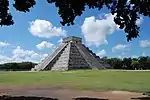Xlapak
Xlapak (or Xlapac) is a small Maya archaeological site in the Yucatan Peninsula of southeastern Mexico. It is located in the heart of the Puuc region, about 4 kilometres (2.5 mi) from the archaeological site of Labná and a similar distance from Sayil, lying directly between the two sites.[2] It consists of three main groups in a valley of the Puuc Hills in Yucatán State,[3] a region of karst limestone forming the only major topographical feature of the peninsula.[4] The closest town is Oxkutzcab, about 30 kilometres (19 mi) to the northeast.


The site dates from the Late to Terminal Classic periods and was sited in an area suitable for agriculture.[5]
Restoration at Xlapak, and other nearby archaeological sites, was carried out in the first half of the 20th century by the Mexican Instituto de Antropologia e Historia (Institute of Anthropology and History).[6] Further archaeological investigation was carried out in 1965 under the direction of César A. Sáenz.[7]
The site
The site core is located in the flat valley bottom, while in the surrounding hills the remains of perishable structures have been found.[3]
The main feature of Group 1 is the Palace, which consists of nine rooms with decorated facades. Another palace is located in Group 2, it is decorated with columns.[3] The architecture is an example of the ostentatious style of the Classic or Fluorescent Puuc, in common with the nearby sites of Sayil, Labna, Kabah, and Uxmal.[8] Typical of this style are the highly decorated upper portions of the buildings that extend above the ceiling height.[9] The decorations at Xlapak are well preserved and include masks of the Yucatec Maya rain god Chaac.[1]
Notes
- Digital Collections of the Brigham Young University
- Toscano Hernández & Huchim Herrera 2004, p. 84. Lorenzo Vidal & Muñoz Cosme 1997, p.360. Carmean & Sabloff 1996, p.319.
- Toscano Hernández & Huchim Herrera 2004, p.84.
- Smyth & Dore 1992, p.4.
- Toscano Hernández & Huchim Herrera 2004, p.81.
- Rhyne, p.21.
- Rhyne, p.36.
- Lorenzo Vidal & Muñoz Cosme 1997, p.364.
- Lorenzo Vidal & Muñoz Cosme 1997, p.365.
References
- Carmean, Kelli; Jeremy A. Sabloff (Autumn 1996). "Political Decentralization in the Puuc Region, Yucatan, Mexico". Journal of Anthropological Research. Albuquerque, New Mexico: University of New Mexico. 52 (3): 317–330.
- Carmean, Kelli; Dunning, Nicholas; Kowalski, Jeff Karl (2005). "High Times in the Hill Country: A Perspective from the Terminal Classic Puuc Region". In Arthur A. Demarest; Prudence M. Rice; Don S. Rice (eds.). The Terminal Classic in the Maya lowlands: Collapse, transition, and transformation. Boulder: University Press of Colorado. pp. 424–449. ISBN 0-87081-822-8. OCLC 61719499.
- Lorenzo Vidal, Cristina; Gaspar Muñoz Cosme (1997). J.P. Laporte; H. Escobedo (eds.). "La arquitectura de las ciudades Mayas del área Puuc, Yucatán" (PDF). X Simposio de Investigaciones Arqueológicas en Guatemala (in Spanish). Guatemala: Museo Nacional de Arqueología y Etnología: 360–376. Archived from the original (versión digital) on 7 July 2011. Retrieved 2009-05-16.
- Rhyne, Charles. "Architecture, Restoration, and Imaging of the Maya Cities of Uxmal, Kabah, Sayil, and Labná: The Puuc Region, Yucatán, México" (PDF). Annotated Bibliography of the Puuc Region. Portland, Oregon: Reed College. Retrieved 2009-05-16.
- Smyth, Michael P.; Christopher D. Dore (March 1992). "Large-Site Archaeological Methods at Sayil, Yucatan, Mexico: Investigating Community Organization at a Prehispanic Maya Center". Latin American Antiquity. Washington, DC: Society for American Archaeology. 3 (1): 3–21. doi:10.2307/971927. JSTOR 971927.
- Toscano Hernández, Lourdes; José Huchim Herrera (November–December 2004). "La Región Puuc de Yucatán" (PDF). Arqueología Mexicana (in Spanish). Mexico: Editorial Raíces. XII (70): 80–87. ISSN 0188-8218. OCLC 29789840. Archived from the original (PDF) on February 6, 2010.
